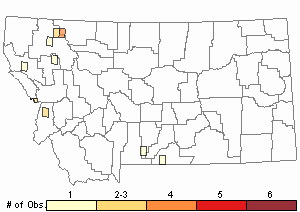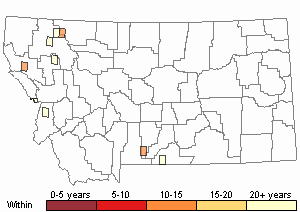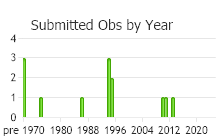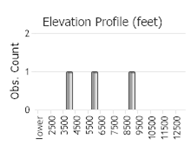View in other NatureServe Network Field Guides
NatureServe
Montana
Utah
Wyoming
Idaho
Wisconsin
British Columbia
South Carolina
Yukon
California
New York
Boreal Haircap Moss - Polytrichastrum alpinum
General Description
Plants: Acrocarpous, growing in open to crowded tufts of varying sizes, from small to large, muted- or brownish-green, becoming more reddish with age. Stems 1-14 cm, but mostly 4-6 cm in length, heavily-leaved above, frequently slender and lacking leaves below, simple or with few branches, or branches bundled together (FNA 2007).
Leaves: Slightly to thickly overlapping, erect-spreading and nearly tubular when dry, erect-spreading to spreading nearly 90 degrees when wet; basal sheath somewhat shiny, obovate or wider in the middle with ends narrower and rounded, the shoulders narrowing, with broad, hyaline borders; leaf tip acute or acuminate; margins 2-5 cells across, roughly serrate, distally more finely serrate or smooth; costa extending shortly beyond apex as a toothed awn (FNA 2007).
Leaf Cells: Lamellae appearing smooth in outline, 5-8 cells in height; the marginal cells of the lamellae in X-section larger than the cells below them, “strawberry-shaped,” yellow to deep brown, ovate or narrowly so, the side walls quite thick, and the cell cavity 5-sided and pointed toward the top, papillate. Median cells of the leaf sheath long-rectangular and fine-walled; marginal laminal cells nearly square, occasionally elongated crosswise (FNA 2007).
Polytrichastrum alpinum var. alpinum: Present in Montana (FNA 2007). Stems mostly 4-6 cm in height, varying from 2-10 cm, simple to branched in bundles. Leaves roughly toothed, (4-)5-8 mm in length (FNA 2007).
Polytrichastrum alpinum var. fragile: Stems 1-2 cm in height, in dense tufts. Leaves delicate, constricted where sheath and blade meet, the blade falling off easily; margins of blade smooth, seldom toothed distally (FNA 2007).
Polytrichastrum alpinum var. septentrionale: Present in Montana (FNA 2007). Stems in crowded tufts, to 2 cm in height, slight and wiry. Leaves strongly overlapping, nearly erect, grooved and incurved when dry, spreading when wet, blade enduring, not delicate. Margins of blade usually smooth, or may be serrulate near the tip (FNA 2007).
Polytrichastrum alpinum var. sylvaticum: Stems to 14 cm in height, simple or with few branches. Leaves mostly 12-14 mm, varying from 9-19 mm in length, roughly toothed (FNA 2007).
Diagnostic Characteristics
This species displays wide variation in size, habit, leaf dentition, and sporangium shape. However, the species can be identified, no matter the form, by the smooth-margins and coarse papillae of the lamellae, and the capsules round in X-section with smooth, non-porose exothecial cells.
Meiotrichum lyallii and Pogonatum urnigerum resemble P. alpinum in the sterile state, but can be distinguished by the marginal cells of the lamellae. Those of P. urnigerum are shorter and wider at the tip; those of M. lyallii are erratically grooved and pitted rather than papillate (FNA 2007).
In the North American arctic, leaf serration and capsule shape are correlated in variety septentrionale. Plants with clearly serrate leaves have cylindric or ovate-cylindric capsules. Those with smooth or nearly smooth margins have ovoid to nearly spherical capsules (Long 1985).
Range Comments
Polytrichastrum alpinum: In Montana, known from Cascade, Flathead, Glacier, Gallatin, Lake, Missoula, Ravalli, and Sanders Counties (Elliott 2016).
Polytrichastrum alpinum var. alpinum: Greenland; Canada: BC, NB, NT, NS, NU, ON, QC, YT; USA: AK, CA, CO, ID, ME, MA, MI, MN, MT, NH, NM, NY, NC, OR, PA, VT, WA, WV, WI; Mexico; South America in moderate climates; Europe; n, c Asia; s Africa; Pacific Islands; Australia; Antarctica (FNA 2007). In Montana, known from Carbon, Flathead, and Glacier Counties (Elliott 2016).
Polytrichastrum alpinum var. fragile: Greenland; Canada: NT, NU; USA: AK; Europe; Asia (FNA 2007).
Polytrichastrum alpinum var. septentrionale: Canada: AB, MB, NL, NT, NS, NU, QC; USA: CA, CO, MT, UT, WA, WY; Europe; n Asia (FNA 2007). In Montana, known from Flathead and Glacier Counties (Elliott 2016).
Polytrichastrum alpinum var. sylvaticum: Canada: BC; USA: AK, OR, WA (FNA 2007).
Observations in Montana Natural Heritage Program Database
Number of Observations: 24
(Click on the following maps and charts to see full sized version)
Map Help and Descriptions
Relative Density

Recency



 (Observations spanning multiple months or years are excluded from time charts)
(Observations spanning multiple months or years are excluded from time charts)
Habitat
Polytrichastrum alpinum var. alpinum: Crevices and ledges of moist shaded rock (Elliott 2016), soil, humus. From middle to high elevations (FNA 2007).
Polytrichastrum alpinum var. fragile: Needs regular inundation; lake edges, springs, wet meadows, sometimes open tundra. Low elevations (FNA 2007).
Polytrichastrum alpinum var. septentrionale: Soil in alpine and subalpine habitats (Elliott 2016).
Polytrichastrum alpinum var. sylvaticum: Soil, moist forests. Low elevations to 4600 feet (FNA 2007).
Reproductive Characteristics
Seta somewhat brown, (1-)3-5 cm tall. Capsule terete, 1.5-8 mm, mostly 3-5 mm in length, varying from thinly-cylindric and sometimes rounded, to ovoid or nearly spherical, and ranging from nearly upright to practically horizontal; the neck tapering and transversely wrinkled, with noticeable stomata in a wide band; peristome with 45-50 teeth, unequal and irregular in their growth (FNA 2007).
Polytrichastrum alpinum var. alpinum: Capsule 3-5 mm in length, 0.8-1 mm in width, cylindric, short to long, somewhat bow-shaped (FNA 2007).
Polytrichastrum alpinum var. fragile: Capsule egg-shaped or nearly spherical (FNA 2007).
Polytrichastrum alpinum var. septentrionale: Capsule small and nearly spherical (FNA 2007).
Polytrichastrum alpinum var. sylvaticum: Capsule 5-8 mm in length, 1.5-2.2 mm in width, broadest below the middle, ranging from nearly erect to practically horizontal (FNA 2007).
Stewardship Responsibility
References
- Literature Cited AboveLegend:
 View Online Publication
View Online Publication Elliott, J.C. and A.K. Pipp. 2018. A Checklist of Montana Mosses (1880-2018). Updated 3 January, 2020. Montana Natural Heritage Program, Helena, Montana. 73 pp.
Elliott, J.C. and A.K. Pipp. 2018. A Checklist of Montana Mosses (1880-2018). Updated 3 January, 2020. Montana Natural Heritage Program, Helena, Montana. 73 pp. Flora of North America Editorial Committee, eds. 2007. Flora of North America North of Mexico. Volume 27. Bryophytes: Mosses, Part 1. Oxford University Press, Inc., NY. xxi + 713 pp.
Flora of North America Editorial Committee, eds. 2007. Flora of North America North of Mexico. Volume 27. Bryophytes: Mosses, Part 1. Oxford University Press, Inc., NY. xxi + 713 pp. Long, D.G. 1985. Polytrichaceae. In: G.S. Mogensen, ed. Illustrated Moss Flora of Arctic North America and Greenland. 1. Meddelelser om Grønland. Bioscience 17:9-57.
Long, D.G. 1985. Polytrichaceae. In: G.S. Mogensen, ed. Illustrated Moss Flora of Arctic North America and Greenland. 1. Meddelelser om Grønland. Bioscience 17:9-57.
- Additional ReferencesLegend:
 View Online Publication
View Online Publication
Do you know of a citation we're missing? Elliot, J. C. 1993. Second checklist of Montana mosses. Unpublished report. U.S. Forest Service, Region 1. Missoula, MT. 45 pp.
Elliot, J. C. 1993. Second checklist of Montana mosses. Unpublished report. U.S. Forest Service, Region 1. Missoula, MT. 45 pp. Lawton, E. 1971. Keys for the Identification of the Mosses on the Pacific Northwest. Reprinted from 'Moss Flora of the Pacific Northwest'. Published as Supplement No. 2 of the Journal of the Hattori Botanical Laboratory. Nichinan, Miyazaki, Japan. 66 pp.
Lawton, E. 1971. Keys for the Identification of the Mosses on the Pacific Northwest. Reprinted from 'Moss Flora of the Pacific Northwest'. Published as Supplement No. 2 of the Journal of the Hattori Botanical Laboratory. Nichinan, Miyazaki, Japan. 66 pp. Lawton, E. 1971. Moss Flora of the Pacific Northwest. Hattori Botanical Laboratory. Japan: Yamabuki-cho, Shinjuku-ku, Tokyo. 362 pages plus appendices.
Lawton, E. 1971. Moss Flora of the Pacific Northwest. Hattori Botanical Laboratory. Japan: Yamabuki-cho, Shinjuku-ku, Tokyo. 362 pages plus appendices.
- Web Search Engines for Articles on "Boreal Haircap Moss"





